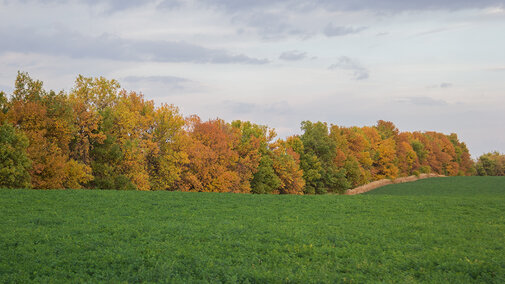Making the Most of Summer Annuals This Fall
As we move into fall, many producers may be looking at harvesting forage from summer annuals like sorghum-sudan or other large-stemmed crops. While these can provide a valuable feed source, making dry hay this time of year comes with some real challenges.
Cooler days and nights, heavy dew sets, and fewer daylight hours all slow the drying process. Add in thick stems and reduced sunlight intensity, and getting hay down to a safe storage moisture becomes difficult. Pushing hay harvest late into the season without good drying weather can increase the risk of mold, heating or even spontaneous combustion in the stack.
If dry hay is still the goal, there are a few steps to improve curing. Mechanical conditioning, like crimping stems, can speed drying. Spreading hay into wide windrows helps capture more sunlight and airflow. And leaving a taller stubble gives the windrow space off the soil surface, reducing moisture wicking from the ground and allowing better air movement underneath.
Even with these adjustments, weather windows can still be tight. Alternatives such as silage or baleage may be a better fit when moisture is high and stems are slow to cure. Stockpiling growth for grazing later in the fall is another option that reduces harvest risk and provides valuable feed, though quality may drop as plants mature.
As you plan fall forage harvest, weigh the risks of slow drydown against the flexibility and feed quality benefits of ensiling or wrapping, or even stockpiling. A little planning now can help protect both forage quality and safety.
Fall Alfalfa Irrigation
Irrigating alfalfa now through November until the soil freezes can protect plants and improve fall yields. However, adjust irrigation rates compared to in-season watering.
During the hot growing season, alfalfa water usage may exceed 0.30-inch per day versus fall cooler days water usage dropping to 0.10-inch per day. As a perennial plant, alfalfa growth extends longer into the fall and does not have specific critical growth stages for water stress like most traditional annual crops. So, when moisture stressed, the plant will slow growth, go dormant, and then resume growth once conditions become favorable again. Generally, maximum alfalfa forage growth requires 5 to 6 inches of water per cutting.
The main advantage of fall irrigation is lower evaporation compared to summer; thus, improving irrigation efficiency. Further, most irrigated alfalfa fields never get much water stored below 4 feet depth, although alfalfa plants can grow roots down 8 feet or more. Since roots will not grow through dry soil to reach wet soil, deep soil water storage reserves may be lacking if field soil wetting does not leach below 4 feet.
To reduce field compaction, pause irrigating two to three days before cutting the alfalfa and irrigate again when alfalfa regrowth begins. Irrigation scheduling efficiency can be improved by using ET (evapotranspiration) measurement gages or soil moisture monitoring.
Review your local NRD irrigation district water usage restrictions, since potential total supplemental water applications per year may have limits, and alfalfa usage could exceed irrigation allocations. Conversely, building deep stored water reserves in the fall can help your alfalfa next summer during rapid growth when it may be difficult to keep up with peak plant water usage demands.
Finally, some fields have lower water infiltration rates, so irrigating now through November may be the right time for building water reserves. “Irrigation Management and Crop Characteristics of Alfalfa” (Nebraska Extension NebGuide G1778) provides more details.
Last Alfalfa Cutting
Timing the last fall alfalfa cutting can be a difficult thing to plan for and varies among growers. A balance between stand health, yield and quality must be maintained.
For much of the state, first week of October is the average first killing frost (28°F) for alfalfa, so targeting Sept. 1 as the last alfalfa cutting would allow plants six weeks to store root carbohydrates prior to the killing frost.
This is important as last cutting timing decisions will potentially impact your crop’s winter survival and vigor next spring. For example, in five-cutting irrigated system, research has shown that the next spring first cutting yield will be lowered by approximately the same amount as the yield from a late fall last cutting.
During dry weather, cutting schedules can be pushed back or more forage may be needed. In these cases, what may be the risk if these producers seek yet another cutting during this growing season?
If the first fall frost occurs earlier than normal, then winter injury is a risk. However, conditions vary from year to year, and plant winterizing generally begins about three weeks before the first frost date, with the “ideal” being six weeks of uninterrupted growth in the fall to become well winterized.
Winter survival of later cuttings will improve with younger stands (except new stands), winterhardy varieties and disease-resistant varieties. For those needing extra cash or forage this fall, the higher dairy quality forage values may offset the financial risk of needing to reestablish alfalfa stands next year that winterkill.
For most producers, the best strategy is to avoid harvesting alfalfa (Sept. 1 to Oct. 15) during the critical fall period six weeks before the first killing frost. This allows plants to enter winter with higher root carbohydrates.

